UPDATE: I no longer use the Beast Sensor. I now use and strongly recommend the VITRUVE velocity based training (VBT) device. It’s far more accurate since it uses a linear encoder to measure velocity instead of an accelerometer. High accuracy is essential for doing VBT effectively.
Use my code KING for 5% off when you purchase your VITRUVE VBT device. You can read my VITRUVE VBT device review for more information.
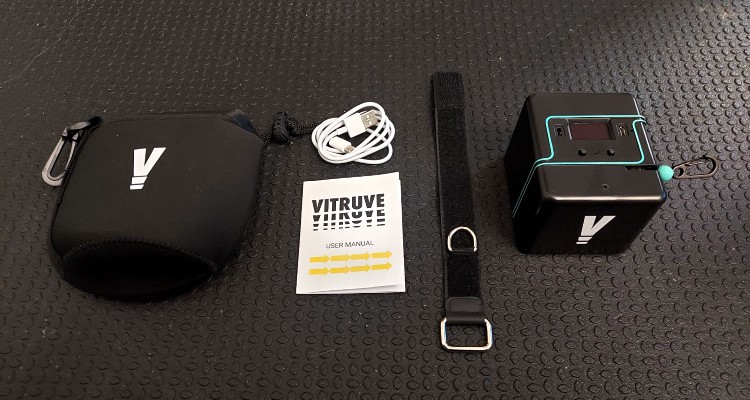
Use Code KING for 5% OFF – VITRUVE VBT Device »
We live in an amazing time. Society is more fitness-conscious now, than at any other point in human history. This surge in the popularity of fitness, combined with the newly-available technological capabilities of the digital age, has led to some amazing advances in fitness tracking devices…
…Which brings me to the point of this article: To review the Beast Sensor.
There are a great many fitness wearables on the market today, but the Beast Sensor is one of the few that’s tailored to weight training. Since my blog is dedicated to all things weight training, this Beast Sensor review was a natural fit.
I was very excited to test the Beast Sensor (which I did for nearly 4 months) and write about my findings. If you have any questions about this product, just ask in the comments section.
Table of Contents
Overview: What Is the Beast Sensor?
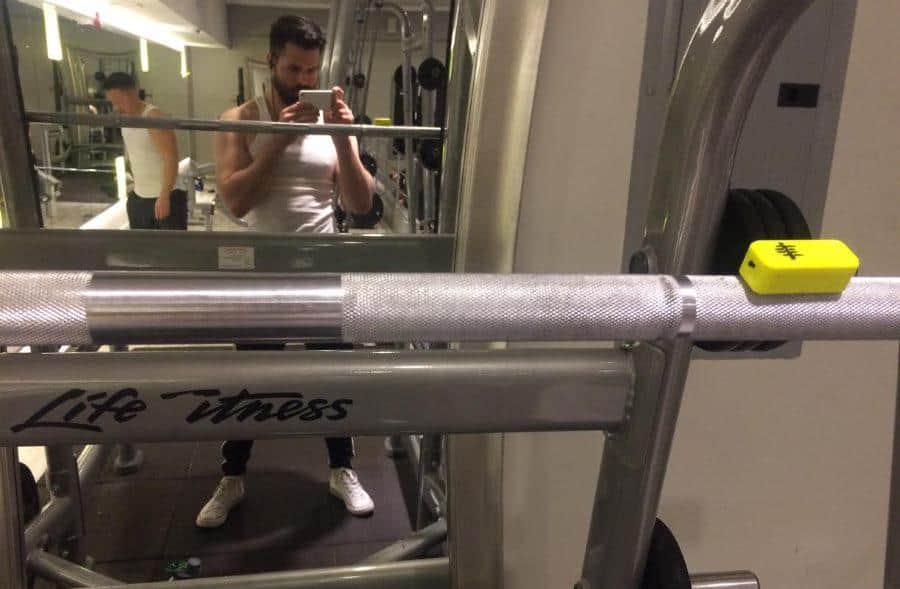
The Beast Sensor is small piece of physical hardware that you attach to the bar or your body to track speed data, which is transmitted in real-time to an app on your smartphone.
This is highly valuable training data, which is used to inform your training decisions on set-to-set basis and to track your progress overtime.
Here’s a cool video that will give you more context and see the Beast in action:
My Reasons for Getting the Beast Sensor
1. To Renew My Motivation
Any product that makes someone’s fitness journey a seemingly less monumental task is incredibly important to me.
Personally, I have gone through some points in my own training that have been incredibly stale to the point of mind numbing monotony.
Even though my motivation was still alive and well in terms of getting myself to the gym and picking up the weights, I was getting extremely bored.
However, my motivation to stay dedicated to my pre-programmed numbers based on percentages of my one rep max or even based on the RPE scale, was not what it used to be.
2. Use Better Incentives to Stop Ego Lifting & Stick to My Programming
My boredom led me down a path of rekindling the flame of my enthusiasm for training by listening to my ego and really pushing the weight on the bar (even though I absolutely knew better).
Instead of sticking to my programming and investing in the training process, I started shifting my training more towards that of a typical gym “bro.”
Problem(s) Solved
Both of my above-mentioned issues – the boredom and the temptation to always go heavier – were addressed with the Beast Sensor.
Specifically, here’s how the Beast Sensor helped me:
- The monotony of training became broken and excitement was brought back to my routine again because of all of the new variables I was working with.
- The quantifiable measures of my training become vastly improved and more specific.
- Being able to work in my specific intensity and velocity zones caused my “ego lifting” to remedy itself immediately.
- Instead of focusing on the weight on the bar, I got to focus on improving the speed of the bar with different weights on it.
Overall, the device was instrumental in making my own training a much more enjoyable and efficient process.
The Exercise Science Behind the Sensor: Velocity Based Training (VBT)
The Beast Sensor was built around the concept of Velocity Based Training (VBT).
What Is Velocity Based Training?
So, what exactly is VBT? Here’s my definition…
Velocity Based Training uses the metric of bar or body speed (i.e. velocity) to narrow in on the correct load for a given exercise set, with different target velocity ranges for different training objective (i.e. velocity, max strength, power, hypertrophy).
Velocity is typically measured as the average velocities of all reps within a set. Ideally, the measurement is done with some sensor (like the Beast) or a comparable tech-based device.
Technically, you could do a very rudimentary form of VBT by having a lifting partner time your reps, or even just estimating velocity based on how fast or slow each set feels. Obviously, both of these methods – especially the latter – are very flawed and bound to produce inaccurate or inconsistent readings.
As implied in the definition, your target velocity is based on your training objectives (e.g. strength, hypertrophy, power have different velocity ranges. I’ll discuss these ranges later.
If you still don’t really understand VBT, you can compare it to these two other popular strategies for determining weights for each set:
- Percentage-Based Training
- Autoregulation
Below, I’ll discuss both of these training strategies and how they compare to velocity based training.
Percentage-Based Training vs. Velocity Based Training
This is the oldest strategy for determining weights. Generally, this is all done at the beginning of your training cycle. First, you test (or estimate) your one rep max for the main lifts. Then, you calculate the weights for each set depending on the exercise and training objective (e.g. for strength-focused sets, you might use 90% of your 1 rep max).
The big plus of this strategy is that it’s simple to calculate and you just have to do it once.
Usually, the percentage-based approach gets the job done good enough–it’s the quick and dirty option.
BUT, it has some major flaws:
- Rigid: Your weights are determined at the start of your cycle. However, this doesn’t account for your good days and your bad days. So, some days the weight will feel too heavy, and other days it will feel too light.
- Potentially inaccurate: If you base your 1 rep maxes on estimates from a 1RM calculator, your calculated 1 rep maxes can be significantly different than your true 1 rep maxes. This of course translates to using weights that are too heavy or too light on your working sets throughout the training cycle. Similarly, if you actually test your 1 rep maxes, this can still lead inaccurate programming. For example, if you test your maxes on a day where you’re feeling amazing and everything is falling into place–then your maxes may be “artificially high” for lack of a better term, which could lead to your working set weights being too high on most of your training days. And the opposite is true if you test maxes on when you’re feeling bad and nothing seems to be going your way.
In comparison, VBT is:
- Flexible: It allows for natural workout to workout variation in performance.
- More accurate: The load used during a set is secondary to the velocity of that set. That is, the load used for a given set is necessarily accurate as long as it is performed in the target velocity range. Lastly, the velocity measurements are taken by a sensor, which obviously doesn’t “care” how fast or slow you lift. It is objective and consistent, assuming of course that it’s a good quality sensor and you’re using the right way.
Autoregulation vs. Velocity Based Training
Autoregulation is a newer programming strategy than percentage-based training. It involves choosing the loads of your sets based on how easy or difficult the weights feel on a given training day. This is commonly done through the RPE (rated perceived exertion) scale.
The RPE scale is a scale of 1-10, with 1 being light activity and 10 being max effort. In this type of program, different sets would have different target RPE ranges. You would increase or decrease the weight as needed to hit the target RPE range
RPE Example: If you do 405 lbs for your first set of 3 reps on squats and your target RPE is 7-8, but it’s more difficult than you expected – maybe a RPE 9 or 10 – then you’d decrease the weight for your next set accordingly.
Because of this built-in flexibility, autoregulation is generally a more accurate and effective system than percentage-based training.
However, there is one notable flaw with auto-regulation:
- Subjective: The RPE rating is based on your subjective interpretation of how difficult a set is. While this is positive in that it allows for real-time adjustments in your training loads, it can be a negative because subjective ratings are prone to inaccuracy and inconsistency. For example, if you’re feeling off, that doesn’t necessarily mean your actual performance and technique is actually reduced from what it would be otherwise. However, your RPE would be lower, which would lead to using less weight than optimal. Another possibility is that you may consistently underestimate or overestimate your RPE depending on your personality or behavioral tendencies (e.g. if you’re more passive, careful or lazy vs. aggressive, risk-seeking, motivated).
In comparison, VBT is:
- Objective: With VBT, you’re basing your training loads off of the average velocity of your sets. This is an objective measurement calculated by a sensor (or other piece of technology). Now, it is fair to argue about the accuracy of the device measuring velocity. But, you cannot argue against the objectivity.
The Importance of Velocity
Previously, the only measuring devices available for bar velocity and force production were either a Tendo Unit meter or an actual force plate installed in the floor. With either choice, thousands of dollars, tons of space, and numerous limitations in the movement dynamics of the athlete really put a damper on the capabilities of the tools.
Being able to quantify speed of movement allows for incredibly specific/individualized training. One could argue, aided by droves of scientific research, that velocity based training is the only way to maximize human performance.
Speed of movement can help autoregulate (automatically regulate the level of intensity and effort) training…
…However, without a tool giving consistent and quantifiable velocity measurements, you’re basically just guessing.
When looking to train in specific velocity zones, you’ll know that:
- Enough work has been done once the average speed of movement slows down due to fatigue setting in and degradation of technical form. Or…
- The weight/intensity needs to be adjusted because the velocity is too slow (because the closer to max weights you get, the slower the bar moves).
With this information in mind, let’s take a look at some of the Beast Sensor’s benefits, features and product specs.
Beast Sensor Benefits, Uses & Specs
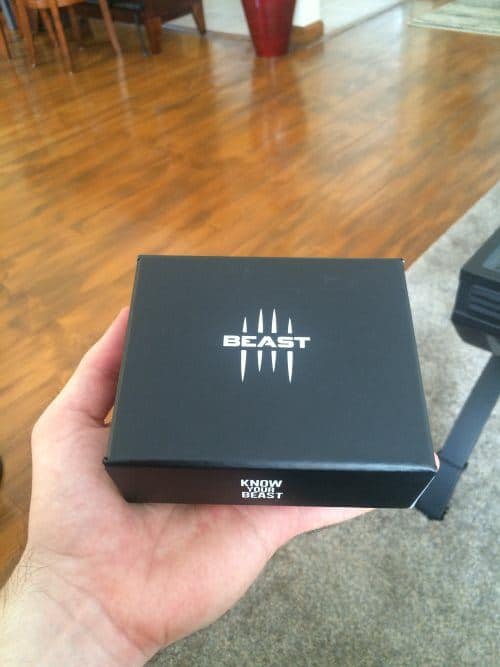
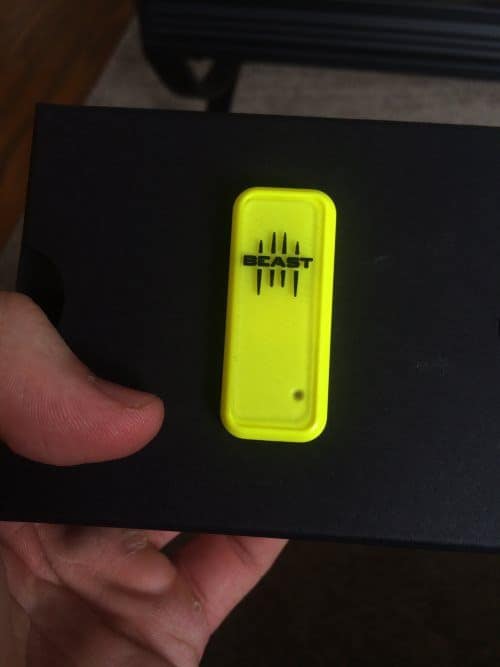
Benefits
The Beast Sensor is a training tool that is:
- Portable
- Affordable
- Versatile
Uses
It can very useful for anyone interested in:
- Powerlifting
- Bodybuilding
- Weightlifting
- Crossfit
- Making their fitness programs as specific and efficient as possible
Product Specifications
- The unit itself is 20mm x 19mm x 40mm
- It weighs 38 grams
- The sensor is comprised of three accelerometers, three gyroscopes, and three compasses
- The battery is a lithium ion and has a lifespan of 8 hours
- It uses a micro USB Charger
Features
The wearable sensor (the actual Beast Sensor Unit) has a bunch of neat features. I’ll go over these, below:
Attach Anywhere with a Built-in Magnet & Wrist Strap
It has a built in magnet that allows you to attach it anywhere. Here’s the specific ways it can attached to you or the bar:
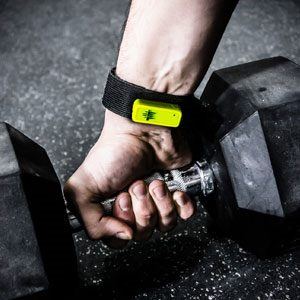
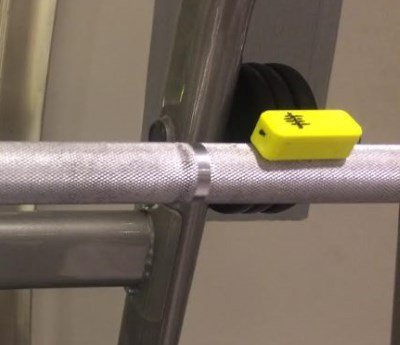
- Directly on the Bar or Weights: You can magnetically secure the unit itself directly to a barbell, dumbbell, weight plates or selectorized weight stack with no special accessories.
- Included Wrist/Ankle Strap: There is small metal piece inside the band for attaching the magnet, plus an elastic strip that goes atop the unit to further secure it. Attaching it to your wrist or ankle in this way allows for monitoring limb velocity in upper and lower body resistance training.
- Optional Beast Vest: You can magnetically attach the unit at several different contact points on the Beast Vest, which is an optional accessory (more on this later). This is perfect for tracking body weight movements like jumping and changes of direction.
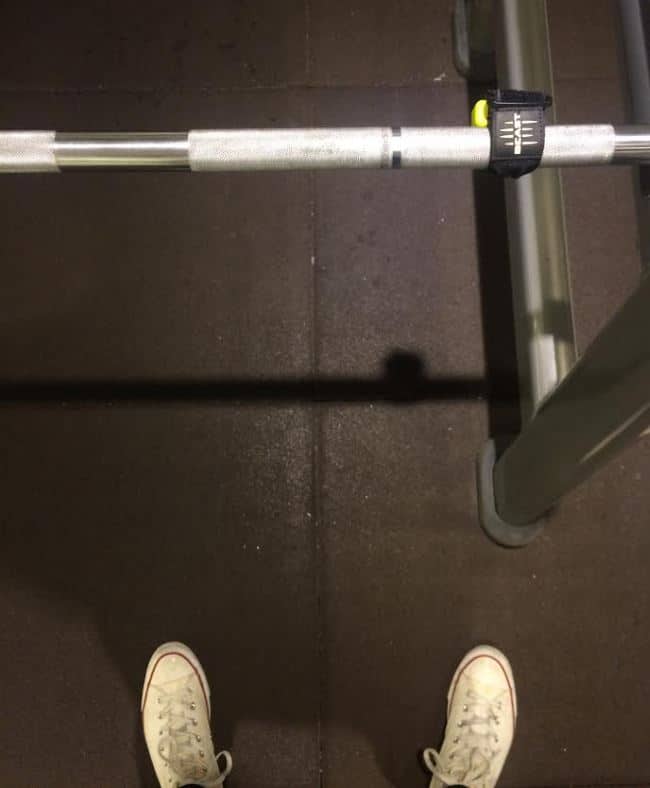
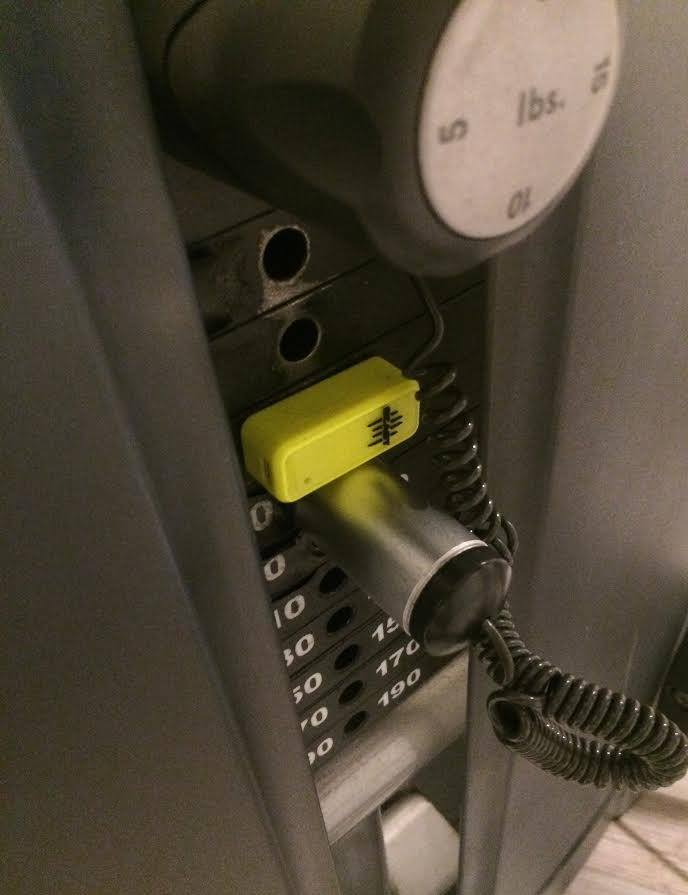
I prefer to attach the unit directly to the bar or weights. It seems to work the best for most exercises in my experience.
The main reason I don’t use the wrist strap on some exercises is that it can pick up extra arm movements before and after the actual weight is lifted. Even though that data can be erased pretty easily, it is still annoying dealing with it on every set you are trying to monitor.
However, the wrist strap does have a major benefit Olympic lifts, deadlifts, rack pulls, Pendlay rows and any other exercise where the bar is lowered aggressively/dropped. If you try to just attach the sensor straight to the bar, the sensor will move around, pick up ghost reps from bouncing/shaking or fall off if the force is high enough when the weight slams down.
As such, I’ll usually wear the sensor on my wrist for these exercises…
…Though, I’ve been playing around with wrapping the wrist wrap around the bar with the sensor inside it, in order to fully secure it and prevent any movement. This works decently well most of the time. However, it may still pick up ghost reps if the bar itself bounces up and down or enough vibration passes through it. This has been an issue that I’ve found is unavoidable on heavy rack pulls, and so I just stick to using it on my wrist on this exercise.
Lastly, the Beast Vest costs extra money. I haven’t purchased it, but I will eventually because I’m interested to see how it works.
Real Time Feedback Allows for Greater Versatility & More Customization
The Beast Sensor has a lot more versatility that I haven’t even touched on yet. Along with being a more precise measuring tool than its competitors (which will actually be proven in soon to be published peer reviewed research), you get live Real Time feedback from the sensor.
The real time feedback allows for complete freedom in exercise tracking and customization.
So, if the exercise you want to perform is not in the Beast Sensor exercise library, you can invent it and begin tracking it immediately.
As mentioned before, this is one of the only trackers that exist that can be used for tracking explosiveness and rate of force development for body weight exercises like plyometrics. Just keep in mind, it is limited to measuring vertical displacement only.
Web Portal Allows for Program Scheduling, Better Progress Visualization & Analysis
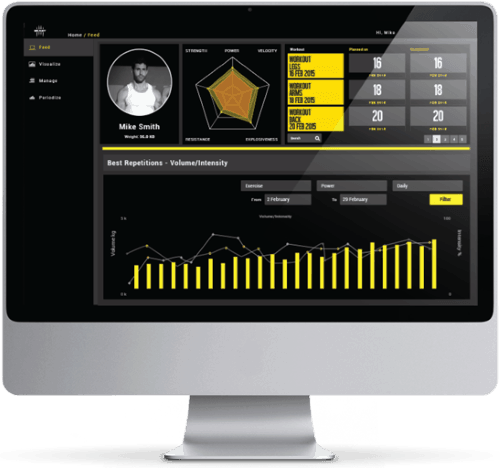
The accompanying web portal is truly unique for the Beast Sensor.
Basically, you get a much more detailed breakdown of your lifts and performance than what appears on the App. Not only are your individual sessions broken down, but they are logged and used to show progress of individual lifts over time.
This means speed, power, strength, general performance and volume are all documented and monitored for you. Not only does it supply information on previous workouts, you can also plan future workouts.
You can also add any new exercises via the web portal to ensure they’re already in the app when you go to workout. You can also add new exercises via the app thanks to a recent update. However, doing it ahead of time in the web portal can minimize the time you spend on your phone during your workout.
Numerous other resources are available in the portal that include suggestions for small group and team training/progressing as well as ways to log and monitor different variations of explosive plyometrics.
Training Modes
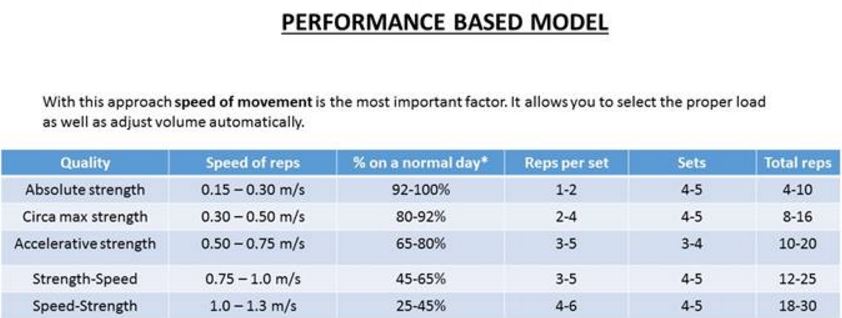
I’ve referred to the different training modes available on the app multiple times throughout this Beast Sensor review. Now, I’ll explain what you need to know about each:
Velocity
This setting is geared towards maximizing speed. Bar speed will always be higher than 1.3m/s and reps will stay in the 3 to 8 range.
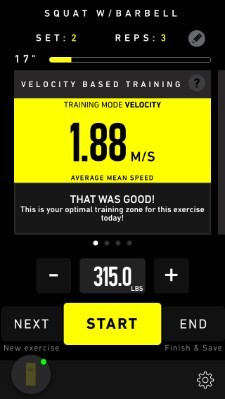
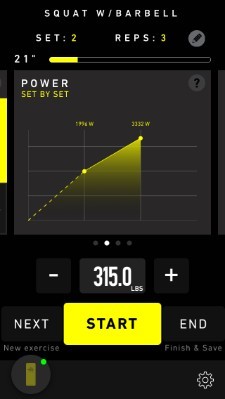
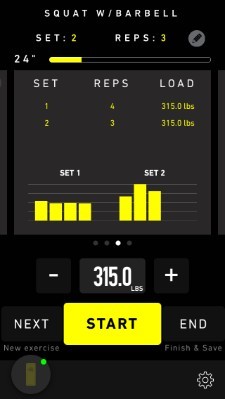
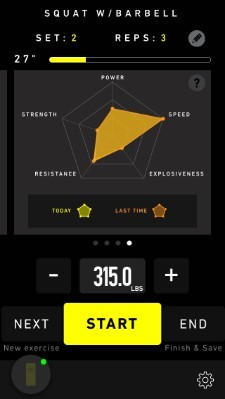
Power
This setting optimizes strength and speed to build peak power output. The range in this protocol suggests .7 to 1.4m/s for bar speed and suggests reps of 3 to 8.




Max Strength
The suggested range here is .1 to .5m/s and for reps of 5 or less. This will develop your ability to produce higher voluntary muscular force.
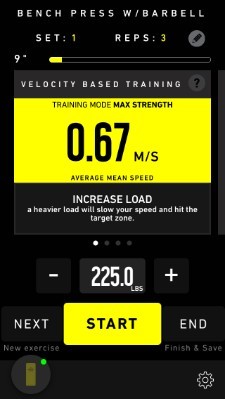
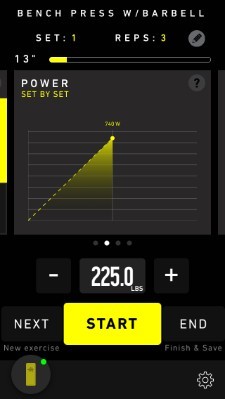
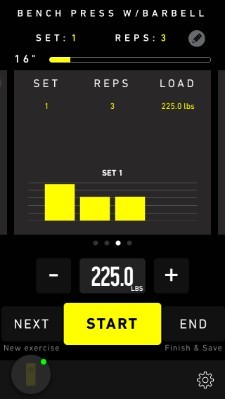
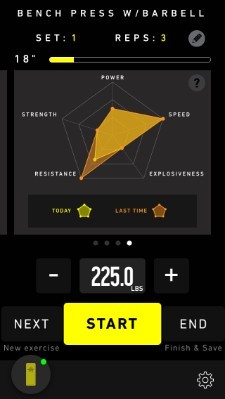
Hypertrophy
The suggested velocity for the hypertrophy training mode .4 to 1.0m/s and for 5 to 15 reps. This range will develop the functional size of the muscles being worked.
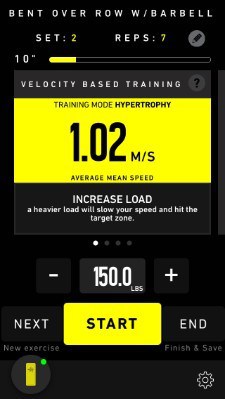
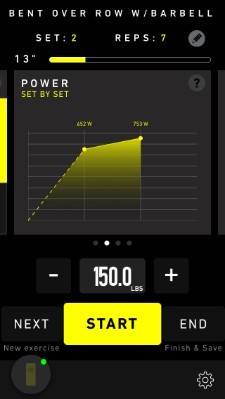
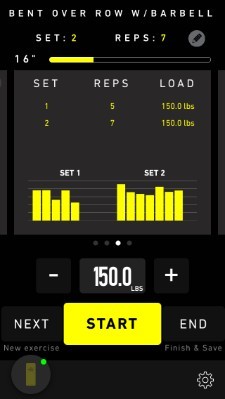
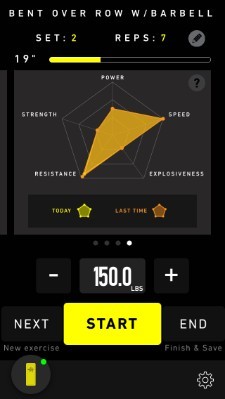
General Performance
The general performance mode has no real parameters to follow and simply just tracks the quantifiable metrics of the exercises you are performing.
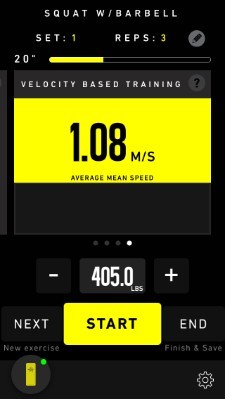
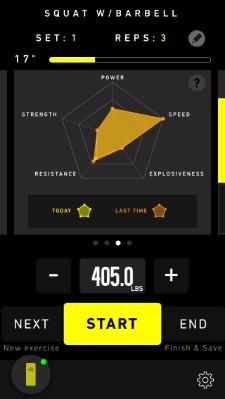
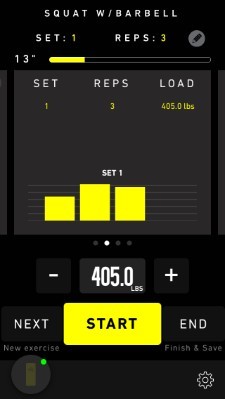
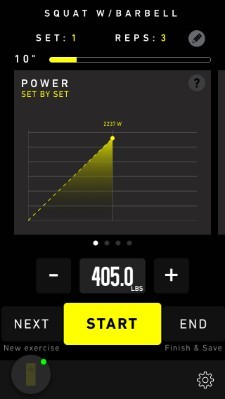
How to Use the Beast Sensor
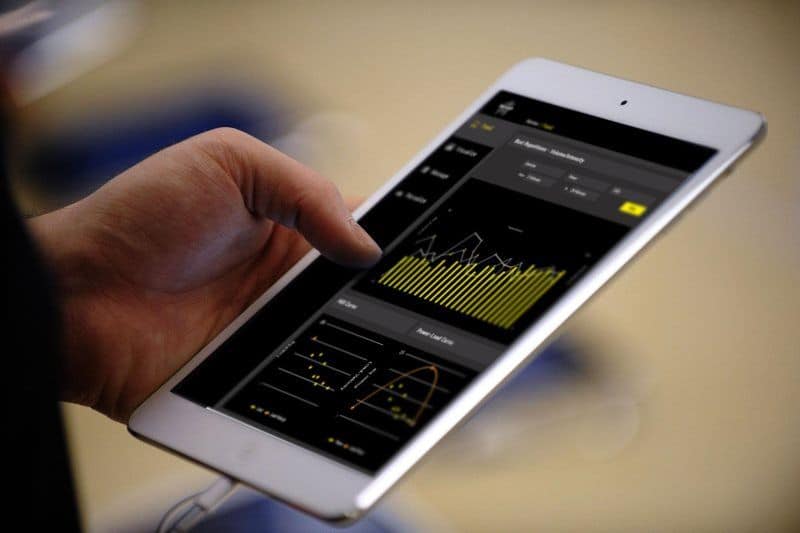
It’s not that hard to get the hang of the process of going through a workout on the Beast Sensor app.
However, I think it’s useful to give you an idea of the general workflow you’ll experience when going through a workout, including:
- a look at the different settings/options
- what the different training mode options look like, and how they’re described
- how to pick exercises
- how to view and edit rep data for each set
- the different data views available for each training mode
Configure the Settings
Settings Screenshot

What Different Settings Mean
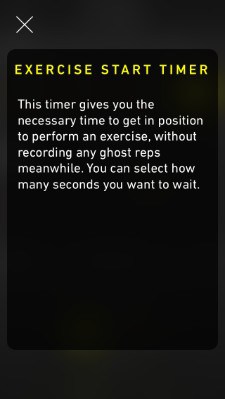
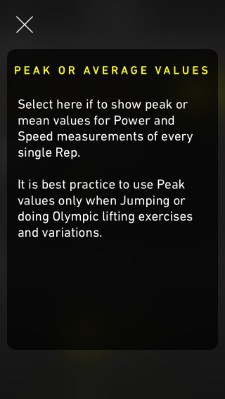
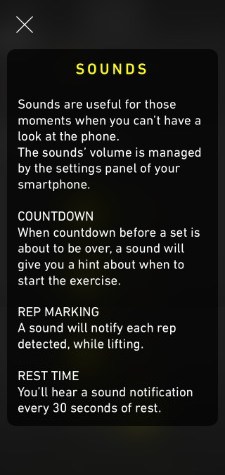
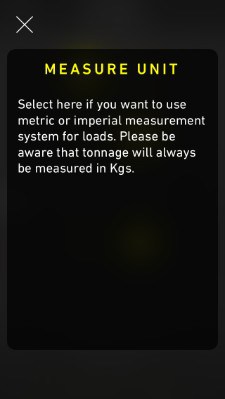
Select from Existing Exercises
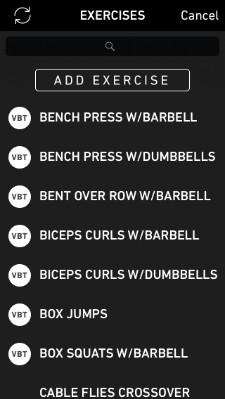
Or Add a Custom Exercise
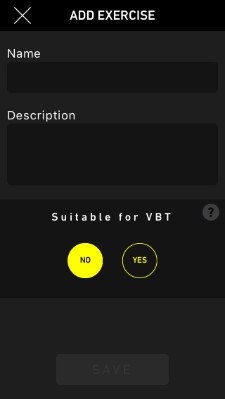
Select Training Mode
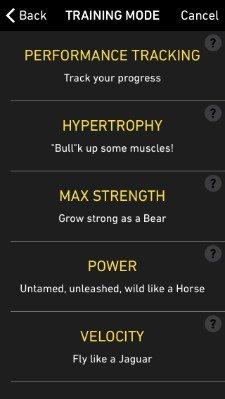
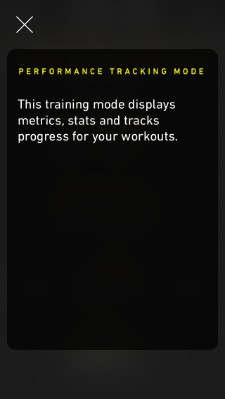
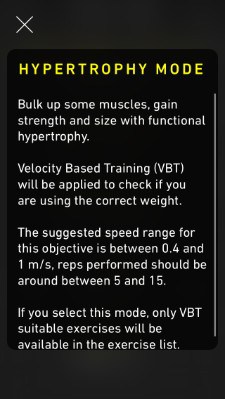
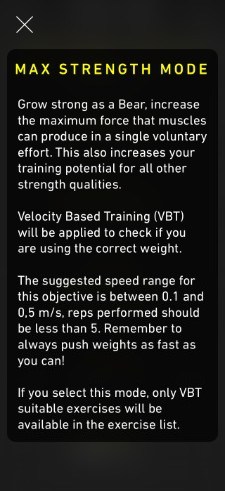
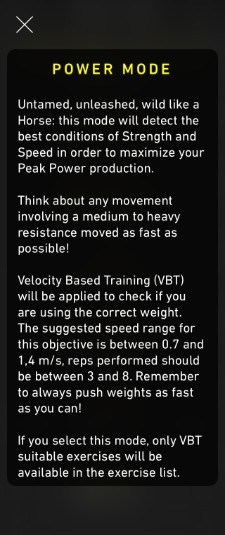
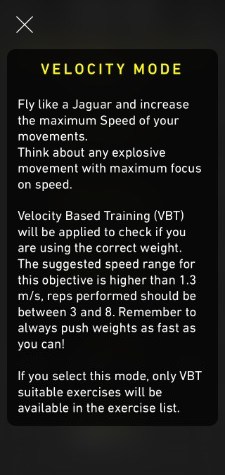
Press Start, Perform Set, Press Stop, Then Review Data




Edit Your Reps or Load If Required
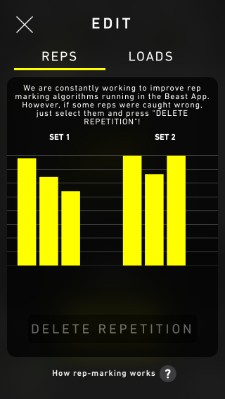
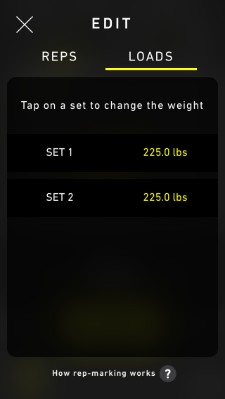
How Rep Marking Works
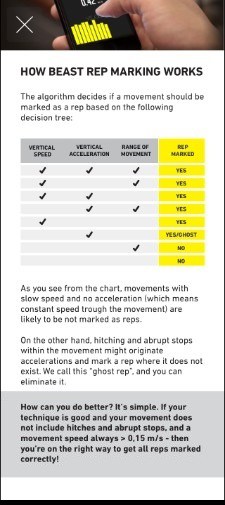
View Week-by-Week Progress After Completing Workout
Weekly Progress Expressed as Tonnage per Week
Tonnage is calculated as: Sets x Reps x Load. To keep things simple, you can basically think of it as total volume.
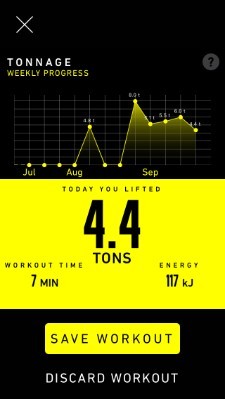
How It Stacks up Against the Competition
What separates this tool from others on the market? I’m glad you asked!
Beast Sensor vs General Fitness Wearables
As opposed to the typical step counters, heart rate monitor and calorie trackers available (e.g. Fitbit), the Beast Sensor is designed for serious lifters.
Specifically, there are 2 key features that separate the Beast from general fitness wearables:
- keep count of sets and reps
- accurately measure bar speed
This data will make it easier for you to completely individualize your training program.
Again, to reiterate what the Beast Senor doesn’t do, it doesn’t:
- track your steps
- monitor your heart rate
- estimate your calories burned
- make sure your chakras are aligned or harness your chi
It is a tool for smashing weights, hitting PRs, and progressing the amount of physical strength you are capable of producing.
Beast Sensor vs Weight Training Wearables and Other Trackers
There are similar tools available on the market. First off, the highest tier products include:
- Force plates
- Tendo Unit Meters
- LPT Systems like GymAware
These are the devices most commonly used for:
- research purposes
- sports performance improvement at the highest levels of competition
Because of those two points, these systems require bulky equipment, at least a tablet or computer to run the data, and a pretty thick wallet. On the low end, these entire systems will run well into the low $2000s for the most basic functions.
Luckily, the Beast Sensor monitors basically everything these systems do for a fifth of the price.
As far as other portable sensors, there are comparable products out there. For example:
- The FORM Lifting Collar
- The PUSH Band
I’ll briefly discuss how both of these compare to the Beast Sensor, below:
The FORM Barbell Collar offers similar features like real time feedback and a $249 price tag for the “athlete” model. However, it does have some drawbacks compared to the Beast Sensor:
- You can only use it for barbell lifts because of the shape of the collar. The Beast Sensor can be easily utilized for basically every non-barbell vertical displacement exercise.
- The long term tracking features of Beast are a little more sophisticated and specific.
The Push Band system of bar speed measurement has the ability for to measure free movement exercise and has a reasonable $289 price tag. This gets you the “Push Band” that can be worn or put on a barbell and will give you real time feedback on your lifts. The only issues here are:
- It does not allow you to add new exercises into its database and any long term tracking is going to require a $1000+ yearly subscription to Push’s web portal service.
- Most people who have tried both devices, have said that the Beast has somewhat better accuracy when counting reps. I haven’t tried the Push Band, so I can’t personally confirm this. But, I did thoroughly research feedback from other users of both devices.
As you can see, the Beast Sensor is still the best choice on the market for having all of the best features of the competitor products without the extra costs.
Who Is the Ideal Beast Sensor Customer?
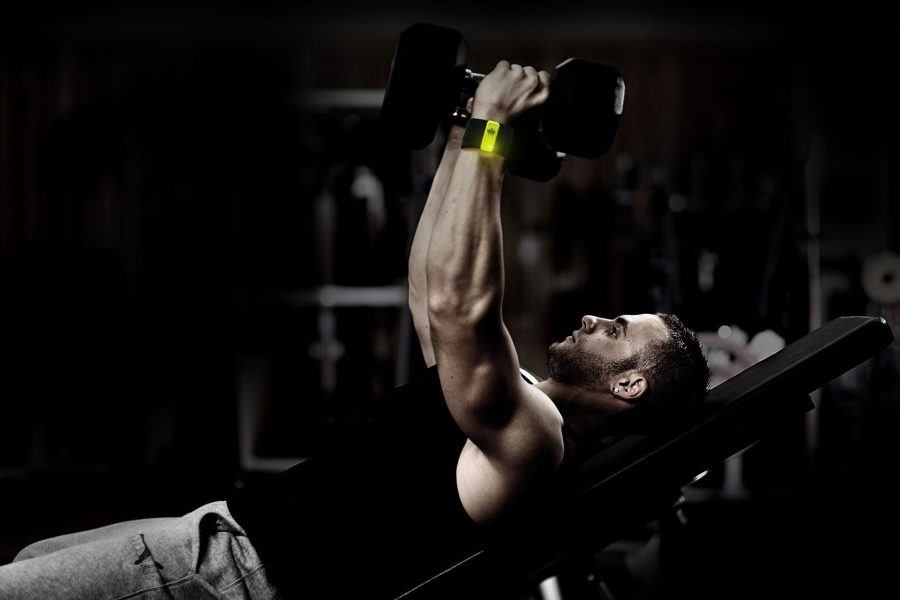
The ideal Beast Sensor customer is a 50/50 split of nerd to meathead. This should be an individual pretty well read on velocity based training, or at least knows where to find charts and graphs of how to apply velocity to different intensity zones.
Also, progress tracking will switch gears. Instead of just following total volume progressions or INOL equations to move your training from one session to the next, you will be able to use metrics like bar velocity and total force output to determine how to progress.
If this sounds complicated, it’s because it is. But, it is also incredibly effective.
Another aspect to keep in mind is that the ideal Beast Sensor user shouldn’t get easily frustrated with new technology that requires a little bit of a learning curve. Even though it is reliable and consistent, without proper introduction to the system, perfection of measurement and use may be hard to attain.
On the flip side of that same coin, there are plenty of “non-ideal” users for the Beast Sensor.
Who Is NOT the Ideal Beast Sensor Customer?
Basically, anyone that doesn’t care about tracking additional lifting data shouldn’t bother with the device. That includes those that have no interest in velocity based training.
Another type of person who shouldn’t get the Beast is anyone interested in velocity based training, but who insists on trying to get away with estimating your own bar speed (either via a partner, video breakdown or by “feel”). If this describes you, just understand that you are in for a time consuming and inconsistent process with much less payoff results-wise.
Also, if you’re brand spanking new to lifting, then I wouldn’t recommend the Beast Sensor quite yet. You need to just on learning basic technique and getting a base of strength before you dabble in velocity based training. Do that for at least a few months, then you can come back and consider using the Beast.
Finally, if you’re not willing to put in small but not insignificant effort it takes to get past the learning curve of using the device and the app, then the Beast Sensor is not for you.
Key Considerations to Make Before Buying the Beast Sensor
Expecting the device to work perfectly while also not being prepared for learning curve required to successfully use the Beast Sensor will result in more frustration than quality training.
Another aspect to consider, the typical flow of most individuals workouts will be interrupted. Even though that interruption to use the Beast Sensor is absolutely worth it for the massive increase in training efficiency, some people will find it hard to deviate from their current training structure.
Other considerations must be taken into account before purchasing a Beast Sensor unit. For example, if you are cutting into your food budget or are going to miss paying a bill that month, it is not worth the trade off. It’s not the most expensive bar velocity tracker on the market but it is also not the cheapest.
Other questions to ask yourself before you buy one:
- Will you actually use it?
- Do you have a history of buying cool gadgets or other products that end up collecting dust because you lost interest?
- Or, do you actually get the most out of the gadgets you buy?
If you are still with me here, that’s awesome! We would probably be friends in real life and have nerdy meathead conversations about force curves and non-insulin mediated contraction dependent GLUT4 translocations. I want to delve a little bit deeper into the actual functions and practical applications of the Beast Sensor.
First of all, it comes equipped with five different training modes. All training modes are defined by different velocity ranges that the sensor measures:
Pros
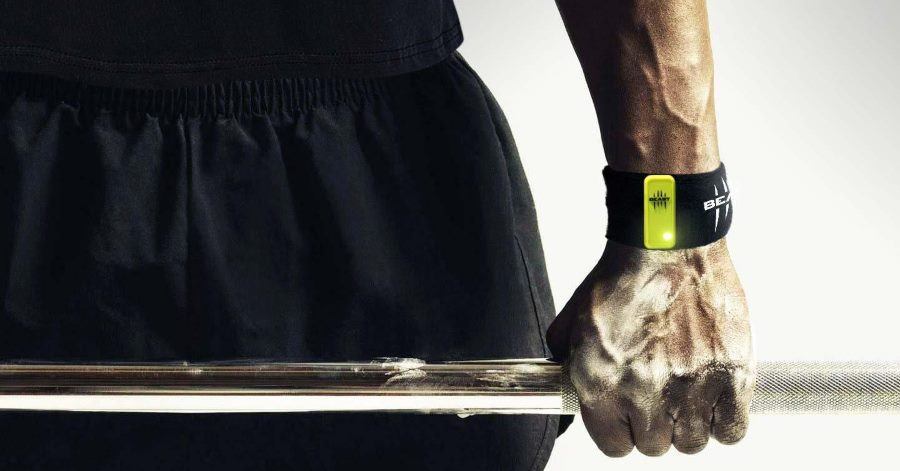
Small Size
The unit itself is super small. A lot of other sensors and units can be either too bulky or in the way of the lift completely when setup correctly.
Versatility
As previously mentioned, the versatility of the sensor will be its most paramount benefit over other velocity measuring tools on the market.
The real time feedback makes an almost infinite amount of data you can expose yourself to for virtually every lift you can possibly imagine. You are basically limited by your own knowledge base and creativity with what you can do with this information.
Encourages Long-Term Progress & Discourages Short-Term “Always Go Heavier” Mentality
When using it for velocity based training, your lifts have a very specific goal of maintaining the required and desired bar speed. This allows you to train in your optimal velocity zone and not chase the weight on the bar specifically.
In other words, you are optimizing your training by not overdoing it and also not under-doing it either.
For people like me, constantly chasing higher and higher maxes in the powerlifts, the sensor gives a readout of quantifiable information just as real as the pounds/kilos on the bar. What I mean is, typical with a lot of heavy lifters, we get wrapped up in always pushing the limits of absolute strength (the most weight we are physiologically capable of lifting).
With the Beast Sensor, we can also focus on some of the harder to quantify qualities that make up the absolute end product. Velocity zones for speed strength, strength speed, and explosive strength can all be perfectly and efficiently developed as well. This is a great commodity for extending heavy lifters training career and helping with injury reduction.
Also, it will help you train more often by being able to have completely control over the Central Nervous Systems response and contribution to the session.
Motivation
The motivation factor should be discussed as well. With the sheer volume of data and then multiple ways to observe said data, serious lifters can now create a whole new set of goals to accomplish.
For example, instead of just saying “I want to squat 500lbs,” once you accomplish that milestone, your next goal could be, “Now I want to squat 500lbs while exerting 700lbs of force into the bar.”
Another way to form goals would be to constantly push the weights in your velocity zones. Increasing the intensity of your explosive strength work will directly transfer to a higher absolute strength max.
Also, with this new information available, you will be able to be completely aware of your current abilities, weaknesses, and exactly how to attack those weaknesses.
Warranty
Another huge plus is the 2 year warranty in Europe and the 1 year warranty available in the USA and all other non-European countries. The reason for Europe having an extra year stems from the company being based out of Europe.
This covers parts, labor and any defects that. Notably, it doesn’t cover damage from normal wear and tear, abuse/misuse (e.g. dropping, crushing), moisture exposure (e.g. spills, submersion). This is standard and expected for just about any manufacturer’s warranty.
Basically, you’ll be fine as long as you don’t crush it or drop it in your protein shake.
If you want additional details on exclusions and other specifics, be sure to read the full warranty.
Having at least a year of this type of coverage gives peace of mind, which most people including myself, need before buying anything that costs a couple hundred bucks or more.
Cons
Learning Curve: Avoiding Ghost Reps & Missed Reps
There is a definite learning curve with the sensor. Both in terms of the unit itself and interpreting the data. It really depends on how you approach this though. It can be considered a huge “pro” when you consider that you have to actually learn a little bit more about the regulation and progression of your training.
Over time, you will become more efficient at shortening the time spent changing weight and fixing the ghost rep phenomena.
Any hitching or abrupt stop/starts during a lifts can cause this misread. This is a result of how sensitive the gyroscopes and velocity detectors are in the sensor itself.
Luckily, ghost reps are easily deleted and there should be a new patch soon that will allow for more accurate measuring of heavier/slower acceleration movements.
Also, it’s possible to experience the opposite of ghost reps: missed reps. This is rare compared to ghost reps, but it does happen from time to time. That is, the sensor may not count a rep that you did in fact perform.
Missed reps may happen if a rep is performed at a constant speed with no relative change in acceleration and little distinction in the transition from eccentric to concentric. Examples include eccentric focused work, one rep maxes and reps that are real grinds. With that in mind, loads around 95%-100% might not be ideal when using the sensor because the inherent speed of max weights may make them not register on the sensor.
Process to Start Tracking Each Set Could Be Smoother
Forgetting to hit the “start” button can be frustrating but is fixed with practice. Effectively selecting your correct mode (between velocity, power, max strength, hypertrophy, or general performance tracking) is a combination of art and science that takes several sessions of use to dial in.
The “start” command on the app must be synched up with the start of your movement. This will take some practice. Luckily, the App comes with a 3, 5, or 10 second delay.
It does help greatly to be able to see your phone before and during each use. This is why Beast Sensor makes a separately sold mount for your phone to keep it secured in front of your face while you lift. Realistically, you could totally build your own mount or find one cheaper that accomplishes the same goal.
If there is nowhere to mount the phone or set it where you can see it, then you can configure the audio settings to beep in sync with the countdowns.
Also, something that drives me absolutely nuts is that audio from other music playing apps may not work effectively or even at all if the Beast Sensor App audio is engaged. This includes any podcasts, Spotify, system music, etc.
According to the a Beast Sensor rep, they are aware of the issue and it is currently being looked at.
For anyone smarter than me (because I have no idea what this means) but the issue is the “low energy” Bluetooth connection with the Renesas-BLE and how it interacts with other audio sources… whatever that means.
The rep ensured me that if they find a solution that won’t interfere with other updates they have planned, they will move forward with the fix.
A Pro AND a Con: You’ll Use Better Technique Because You Have to
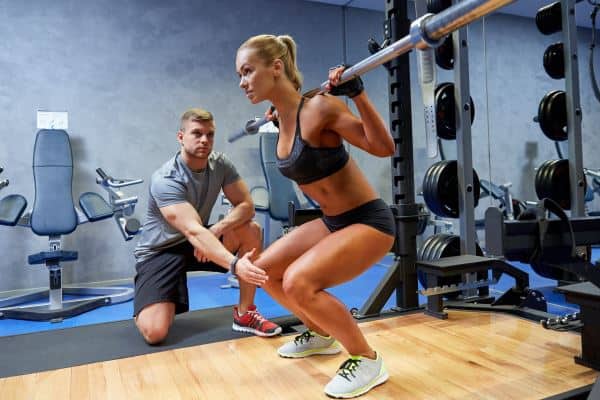
As I’ve already touched upon before, the sensor picks up any movement in a vertical plane. This of course is what causes the ghost reps I mentioned in the “Cons” section above.
Sudden up and down movements like extra wiggle at the top of a squat or the impact vibration of a bar hitting the floor may register as its own individual reps. If this data is not deleted, it will skew the rest of your lifting information.
This may sounds like the Beast Sensor is overly sensitive but that’s part of the beauty of its design. That sensitivity allows for all of the versatility and real time data turnaround. Plus, this technology is still in its infancy.
The development team is constantly looking to improve upon the sensor itself and the algorithms associated with the actual data collection (which will probably be seeing more improvements soon once the peer reviewed research is published). Software updates and patches are constantly being released to fix system bugs.
To reduce the occurrence of “ghost reps” — do the following:
- Use Better, More Controlled Form. If your form is already terrible and you are aware of this, make sure to fix that before you start purchasing gadgets like the Beast Sensor. If you have some training experience, but have some extra little wiggle under the bar during certain lifts, the sensor might be a good reinforcement tool to make sure you aren’t wasting a ton of energy by moving too much with heavier lifts.
Best For People Who…
Again, just to reiterate the sheer awesomeness of the Beast Sensor, I just want to re-mention and expand on some of its more appropriate uses.
As mentioned several times previously, you must be ready to utilize Velocity Based Training. This style of training involves using bar speed as a way to regulate volume and intensity to make sure you are doing enough actual work and not overdoing it at the same time.
Basically, once your lifts drop below your velocity zone, you’re done with that lift for the day because the desired benefit of training is being lost due to fatigue. If bar speed is too fast, you know that the intensity is not enough to elicit the desired gain.
So, you use your velocity zone to “fine tune” the weight on the bar in order to make sure the speed of movement matches the goal for the day/program as a whole.
Along with the velocity component, you’re going have droves of other data to collect. This has to be of interest to you. If you don’t like data, you will get bored.
The sensor is most practical for the main lifts in the workout. Specifically, speed and power oriented movement.
You could also track the velocity trends of your hammer curls if you really wanted to, but if this is the lift that’s most important to you, you might want to double check your priorities.
If you really want to do velocity based training or at least integrate some component of — but you you don’t want to use the sensor every workout, even if just for the main lifts — there is one approach that will still reap some of the benefits of VBT and allow you to harness the sensor’s progress tracking capabilities:
- Use Periodic on the Same Lifts. You can use the Beast Sensor to track certain lifts periodically. Not every lift all the time. This makes the whole system ideal for serious coaches, trainers, and athletes working in the realms of high intensity sport development. It also helps any user who wants to have some workouts where the only focus is you and the weights–no distraction from the sensor or anything else.
Accessories
Beast Vest
This piece is perfect for body weight movements like push-ups, pull-ups, and really any explosive plyometric exercise.
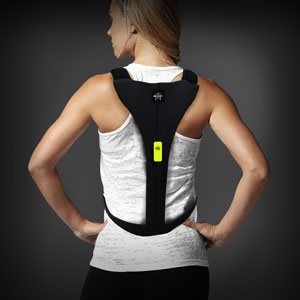
This really might be the only velocity measurement tool on the market that can be used to track plyometrics over time.
Rack Mount for Smartphone
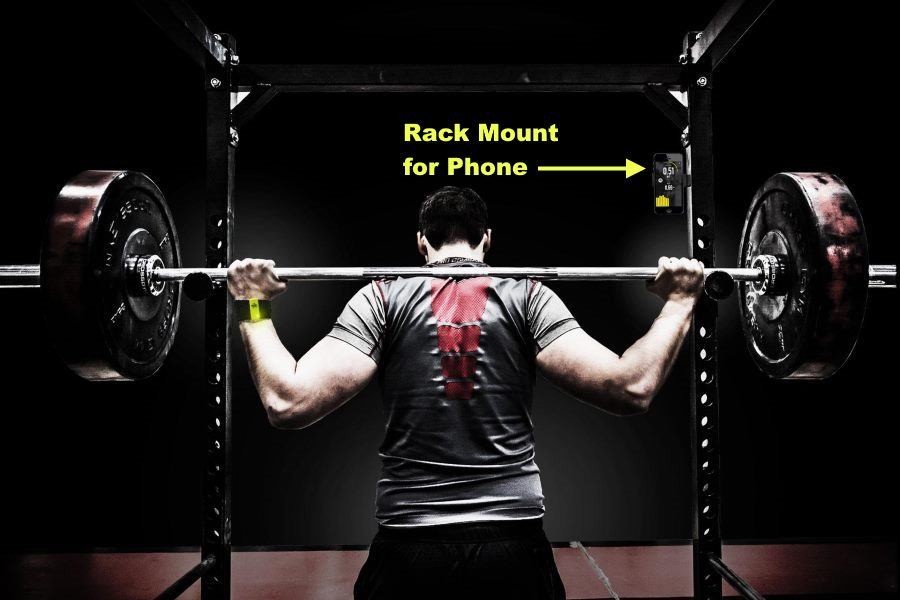
This holds your phone and attaches via magnet to anything metal (like a power rack). This keeps all stats right in front of you and makes “starting” and “stopping” data collection modes a heck of a lot easier.
Sports Teams, Coaches & Athletes That Use the Beast Sensor
Numerous sports clubs and teams are already implementing this technology with huge success.
Feel free to check out or contact some of the following organizations to see how they like their experience with the Beast Sensor so far:

Italia
Italian National Soccer Team
Due to its portability, Beast has been adopted by Italian National Soccer team in Brazil for the 2014 World Cup.

FISI (Federazione Italiana Sport Invernali)
Italian National Ski Team (All group A & B teams)
The strength & conditioning coaches of the Italian skiing national team are using Beast to monitor workouts and assess condition on a daily basis.
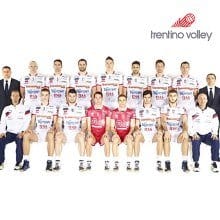
ITAS Trentino Volley
Italian Pro Volleyball Team
One of the most important team in the world of volleyball is using Beast to monitor performances on and off the field.

James Scott
Strength & Conditioning Coach – Shanghai Sharks
“I use the beast because everyday I strive to make the invisible VISIBLE and this device helps me do that.”

Alex Isaly
Celebrity Trainer & Elite Athlete
“The Beast is the perfect tool to measure and help design our training regimen to be as efficient, yet challenging, as possible. It gives us the data to “train with purpose.”

Piotr Haczek
World Champion High Performance Sport Athlete
“Beast has given me an instant access to data which helped in analyzing the session details quicker. It has enabled me to remotely oversee the training which has been extremely helpful in improving quality of the trainings sessions for my athletes.”
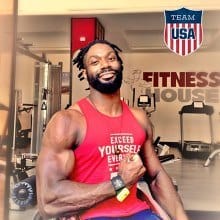
Matt Scott
Team USA – 3x Paralympian Athlete
“The Beast family has been a tremendous support system and the Sensor helps motivate me in the gym to be a stronger athlete.”

Jeff Kruger
Head Strength & Conditioning Coach – Norwich University Football Team
“Favorite Feature: Speed of information & instantly the athlete has feedback that is not subjective.”
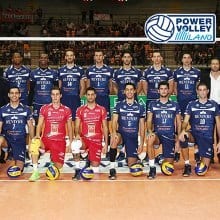
A. Mattiroli
Strength & Conditioning Coach Powervolley Milano
“Beast is a very helpful technology for our trainings; it allows us to monitor efficiently athletes’ explosive strength and power, very important values for volleyball players. Another value added is the possibility to easily record player progresses during the season.”

Jamie Bowie
Scottish 400m Relay Runner
“Beast gives my training another dimension.”

Italia
Italian National Soccer Team
Due to its portability, Beast has been adopted by Italian National Soccer team in Brazil for the 2014 World Cup.
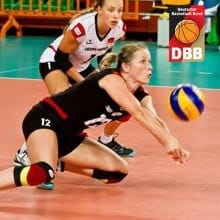
Heike Beier
German Pro Volleyball Player
“Beast is amazing.”

Italian Women’s Water Polo National Team
Italian Women’s Pro Water Polo
The Italian women’s national water polo team competes internationally at the highest levels of the sport, including in the Olympics.

Federazione Italiana Tennis (FIT)
Italian Tennis Federation
Italy’s highest level professional tennis organization, which has been around (under different names) since the late 1800s.

Modena Volley
Italian Pro Volleyball Team
Founded in 1966, Modena Volley is a Italian men’s pro volleyball team, based in Modena, Italy. They play in the highest level pro volleyball organization in country, the Italian Volleyball League.
Image credit: Instagram.com/modenavolley

Munich Cowboys
German Football League Team
The Munich Cowboys are one of the sixteen (American) football teams in German’s elite league known as the German Football League (GFL), which has been around since 1977 and is growing in terms of popularity and talent of the players.

Netherlands Men’s Volleyball
Dutch Men’s National Volleyball Team
The men’s “Nederlands Volleybalteam” (aka Dutch or Netherlands volleyball team) is the national team of the Netherlands.

Colorado State University-Pueblo
CSU Pueblo Athletics
CSU Pueblo is a University in Pueblo, Colorado. The CSU Pueblo teams are known as the ‘Thunderwolves.’
Image credit: GoThunderwolves.com
Recent Updates
Previously, the only way to add new exercises was on the web portal. The most recent update allows new exercises to be added to the library via the smartphone app.
Possible Upcoming Developments
As mentioned, the primary downsides of the system itself are ghost reps and missed reps, with missed reps being most common with max or near max weights.
The development team has been working on that and plan on adding a feature that may allow information on 95%-100% lifts soon. This would be an absolutely incredible development for strength sport athletes like powerlifters, weightlifters, and strongmen.
My Rating: 4 out of 5 Stars
Overall, I give the Beast Sensor 4 out of 5 stars.
It’s small, versatile, has real time feedback, and has reliable consistency and accuracy.
I would have pushed it to a 5 out of 5 if they could find a way to:
- allow music to continue to play with the audio engaged
- get somewhat better at avoiding ghost reps
Even with its flaws, this is still one of best (if not the best) wearable velocity trackers on the market.
Conclusion
The Beast Sensor solves a problem. It solves the problem of efficiently optimizing training to save you time and energy.
Not only is training made more efficient, it is made efficient with tangible and quantifiable data that vastly expands your training horizons. Click here to check out the Beast Sensor.
However, as I mentioned at the start of this review, I now use and recommend the VITRUVE VBT Device over the Beast Sensor. It is significantly more accurate than the Beast because it uses a linear encoder instead of an accelerometer. Accuracy is #1 when it comes to reaping the full benefits of VBT.
In terms of ease of use, it’s also much less frustrating than the Beast. For example, I don’t think I’ve experienced a single ghost rep when using the VITRUVE device, which means more time working out and less time correcting the app.
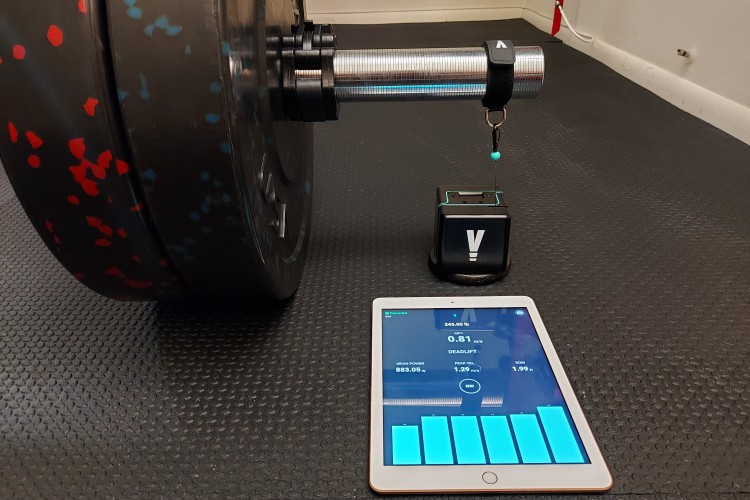

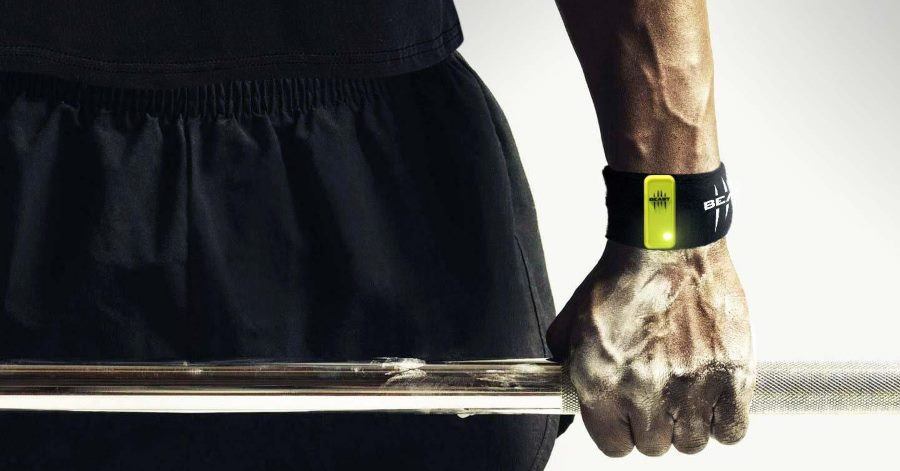

I have purchased one of these and they offer absolutely no after sales service at all and dont respond to email, facebook, etc. I would not recommend this product to anyone. It is extremely inconsistent and the ghost reps occur all the time making it extremely frustrating to use. If they would only respond to my communication so I could return the item I would at least be not bothering with sharing this horrendous experience as one of their customers. Poor form Beast Technologies!!!
Thanks for sharing that, Damien. That sucks, I really hope they get on the ball and respond to you.
Well if you use the push band the beast sensor seems amazing. The push band ghost reps are ridiculous and way worse, the accuracy is way worse, and you cant even delete reps. It has a auto delete system on the push band and it is absolutely horrendous. Push band is also broke on me 3 different times. Beast I never had a problem with and even linear transducers will produce ghost reps sometimes. I think you haven’t used any other product.
Thanks for those insights, Kevin. It’s great to hear from someone who’s used both. You’re right — I’ve only used the Beast so far.
The beast sensor is terrible! DO NOT BUY. The device misses reps and the accuracy is terrible.
If you’re looking for an accurate device that is cheap I would recommend these:
https://www.reponestrength.com/
https://www.flexstronger.com/
Thanks for sharing your experience, Jeffrey. My experience wasn’t that bad, and my main complaint was ghost reps (extra reps) rather than missed reps on some sets if I wasn’t careful with my technique or racking/unracking. In any case, those alternatives look cool. Would love to try one in the future.
Honestly, the sensor causes more frustration than anything. Misses reps all the time, picks up negative portion of rep instead, and values are clearly wrong half the time. Only feel obligated to use because of the cost.